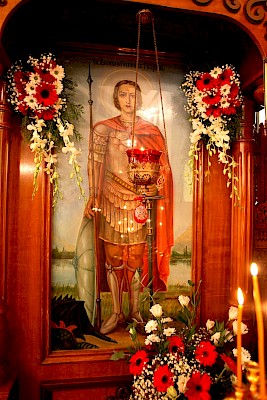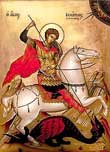St.George Russian Orthodox Church
The Holy and Glorious Great Martyr George the Trophy-Bearer 2018

Today, let us celebrate with joy the bright Feast of Saint George the Trophy Bearer, who was, as the hymnographer of the Church reminds us, “the Great Martyr of the love of Christ.”
St George is one of those saints about whom little is known historically, yet he seems to be popular all over the world. After the Virgin Mary and the Apostles, there are probably more churches dedicated to Saint George including our church in Carlton than to almost any other saint.
We always tend to rely on a miracle in our faith. But the Lord works miracles precisely in the moments when we really need them. In Russia, the biggest miracle is known as Victory Day, and it marks with the Ribbon of St. George.
The Great Martyr George is a protector of the army. The depiction of George the Trophy bearer on a horse symbolizes victory over the devil [the ancient serpent]: "...behold a great fiery red dragon with seven heads and seven diadems on his heads....he laid hold of the dragon, that serpent of old, who is the devil and satan and bound him for a thousand years...." (Rev. 12:3, 20:2). This depiction was included in the ancient coat of arms of the city of Moscow.
It is no accident whatsoever that the holy martyrs became symbols of victory in war: the Holy Great-Martyr George, the Great-Martyr Theodore Stratelates, and many others, because the same thing is required of warriors as of martyrs: faith and fidelity. Faith in God and faith that a warrior is doing the right thing; both this faith and this conviction in the rightness of his cause should accompany fidelity even unto death. It is no accident that the Great Patriotic War [WWII] ended on the day of the Holy Great-Martyr George the Trophy-Bearer. We celebrate Victory Day on the anniversary of the signing of capitulation, which took place in Berlin on May 8 (because of the time difference in Moscow, the time of capitulation was after midnight, for which reason Victory Day is marked on May 9). But the war ended on May 6, on the day of the Great-Martyr and Trophy-Bearer George, who has always been the patron saint of the city of Moscow.
This is not simply a coincidence or turn of events. The war began on the Sunday of All Saints of Russia. Those who conspired to step foot onto our sacred land on June 22, 1941, did not know our church calendar. On the day when all our faithful people were appealing to God, asking mercy of the Holy God-pleasers who had shown forth in our land – it was on this very day, as a great sacrilege and mockery of people’s spiritual life, that bombs began to rain down on the heads of our people.
Celebrating Victory on the day of the Holy Great-Martyr George the Trophy-Bearer, when the way ended, was a response to those who wondered why the enemy attacked us on Sunday, June 22. It was not just the government, which was then the Soviet Union, that the enemy was challenging. For when the lives of millions of people are concerned, it is about much more than the government. It concerns something of colossal value in God’s eyes: the life of the people, faith, holiness, purity, and how we stand before the face of God. A terrible challenge was mounted to all this, and we know the price that was paid by our people for the victory.
Today we pray that the Lord would send down His mercy and love on our people, on the whole of historical Rus’, and on all Orthodox people around the world; that the Lord would grant us a portion of the fidelity and faith possessed by the Holy Great-Martyr George the Trophy-Bearer and the holy martyrs, who became symbols of Victory – the Victory that was accomplished by God’s will.
